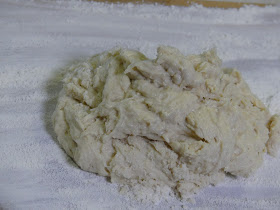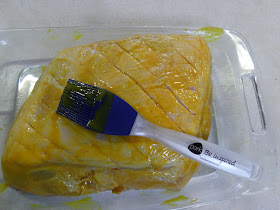1 3/4 cups King Arthur Unbleached All-Purpose Flour
1/2 teaspoon baking powder
1/4 teaspoon baking soda
1/2 teaspoon salt
1/4 cup (1/2 stick) butter
1/4 cup chopped fresh herbs (chives, parsley), or 2 tablespoons dried (optional)
3/4 cup buttermilk
1 large egg
POT PIE FILLING
1/4 cup (1/2 stick) butter
1/2 cup King Arthur Unbleached All-Purpose Flour
3 cups turkey stock, or a combination of stock and leftover gravy
1 teaspoon dry thyme
1 bay leaf
salt and pepper to taste
1/4 teaspoon Worcestershire sauce
4 cups diced cooked turkey or chicken
2 1/2 cups frozen mixed vegetables\
Instructions
To make the dumplings: Whisk together the flour, baking soda, baking powder, and salt. Cut in the butter until the mixture resembles coarse bread crumbs. Stir in the herbs, if using. Cover and refrigerate this mixture while you're making the pot pie filling.
To make the filling: Melt the butter in a 3-quart saucepan over medium heat. Whisk in the flour and cook for 1 minute.
Add the stock 1/2 cup at a time, whisking it into the roux to prevent lumps. When all the stock and/or gravy is added, season with the thyme, bay leaf, salt, pepper and Worcestershire sauce. Simmer the sauce for 15 minutes, then stir in the meat and vegetables.
Return the filling to a simmer, and transfer to a 4-quart baking dish with a lid. Preheat the oven to 350°F.
To assemble: Once the hot filling is in the dish, whisk the buttermilk and egg together, and add, all at once, to the dry mixture.
Stir together until evenly moistened.
Scoop the batter on top of the simmering liquid, leaving space between the dumplings (they'll almost double as they cook). Make dumplings large or small, according to your own preference; we like to top the filling with about 8 to 10 dumplings. Put the lid on top, and bake at 350°F for 25 to 30 minutes.
TIPS FROM OUR BAKERS
If you don't have buttermilk on hand for the dumplings, you could thin 1/2 cup sour cream with 1/4 cup milk. Plain yogurt would also work as a substitute.
You can make the pot pie filling in advance, as well as the dumpling recipe (stop before adding the buttermilk and egg). When you're ready to cook, preheat the oven while you bring the filling to a simmer. Mix the buttermilk and egg into the dumpling mix, scoop, and bake.
This is a good recipe for using odds and ends of vegetables, if you have them: gather any stray mushrooms, onions, carrots and leeks you have in the refrigerator, and saute them until tender before adding them to the sauce.
The steam from the sauce helps to keep the dumplings tender, so try not to peek at them while they're cooking, at least for the first 20 minutes. Your patience will be rewarded with lighter, fluffier dumplings.
Don't mix the dry dumpling mix with the wet ingredients until you're ready to put the casserole in the oven. If you let the mixture sit too long before baking it, its baking powder will lose some of its rise while waiting.


















































